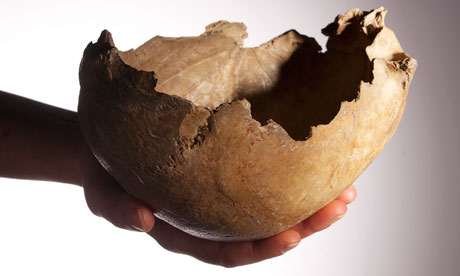A macabre collection of bone cups made from human skulls, unearthed in a Somerset cave, are the oldest of their kind, researchers believe.
The extraordinary vessels are the handiwork of early modern humans, who used stone tools to prepare and finish the containers around 14,700 years ago after the last ice age.
The three cups, made from the skulls of two adults and one three-year-old child, were dug up several decades ago, alongside the cracked and cut-marked remains of animal and human bones at Gough Cave in Cheddar Gorge, south-west England. They have now been re-examined using new techniques.
The human bones show clear signs of butchery, implying that the bodies were stripped for meat and crushed for marrow before the heads were severed and turned into crockery.
There is no suggestion that the cups are trophies made from the remains of dead enemies. It is more likely that making skull cups was a traditional craft and their original owners died naturally.
"It would probably take a half day to prepare a skull cup," said Silvia Bello, the palaeontologist who led the study at the Natural History Museum in London. "Defleshing the skull was a skilled and lengthy business."
Researchers said it was impossible to know how skull cups were used, but historically they have held food, blood or wine. Some are still used today in Hindu and Buddist rituals. "To us they can still seem a little strange," said Bello. "I wouldn't have my cereal in one."
Writing in the journal Plos One, the scientists describe revisiting excavated remains from the cave, including a skull cup unearthed in 1987 by Chris Stringer, head of human origins research at the museum. Detailed examination of 37 skull fragments and four pieces of jaw using a 3D microscope revealed a common pattern of hard strikes followed by more finessed stone tool work that turned a freshly decapitated head into a functional cup or bowl.
"This is the first time we've understood how this material was processed, and the fact that the skulls were not just cut and butchered, but were shaped in a purposeful way," said Stringer.
The discarded human bones had the same cut and saw marks found on butchered animal bones at the site, and some were cracked open or crushed, as was done with animal bones to expose nutritious marrow. Only the skulls seem to have been treated with special care. The cuts and dents show they were scrupulously cleaned of any soft tissues soon after death.
"They systematically shaped the skulls to make them into cups. They scalped them to remove the hair, they removed the eyeballs and ears, they knocked off the faces, then removed the jaws and chiseled away the edges to make the rims nice and even. They did a pretty thorough job,' Stringer said.
The smaller cup, made from the child's skull, would have leaked because the cranial bones had not fully fused together, but the larger two might have carried food or around two pints of liquid.
"We assume it was some kind of ritual treatment. If there's not much food around they may have eaten their dead to survive. Perhaps they did this to honour the dead, to celebrate their lives," Stringer added.
The cave dwellers were among the first humans to return to Britain at the end of the last ice age. The island was unpopulated and almost completely under ice 20,000 years ago, but as the climate warmed, plants and animals moved across Doggerland, a now submerged land bridge that linked Britain to mainland Europe. Where food went, early humans followed and brought art, craft and toolmaking skills with them.
The ages of the remains at Gough Cave suggest it was home to humans for at least 100 years. The cave is well-sheltered and, with skin flaps over the entrance, would have made a cosy abode, Stringer said. The residents were ideally placed to hunt passing deer and wild boar, while up on the Mendip Hills roamed reindeer and horses.
In the 1900s, several hundred tonnes of soil were removed from the cave to open it up as a tourist attraction, a move that may have destroyed priceless ancient remains. The skull cup and other bones unearthed in 1987 survived only because they were lodged behind a large rock.
In 1903, field researchers working in the cave's entrance uncovered Cheddar Man, the oldest complete skeleton in Britain at more than 9,000 years old. A painting of a mammoth was found on the wall in 2007. Other artefacts from the site include an exquisitely carved mammoth ivory spearhead.
A precise replica of one of the skull cups, complete with cut marks, will go on display at the Natural History Museum in London from 1 March for three months.
For more interesting topics related to archaeology, visit archaeology excavations.
Archaeology excavation is best known and most commonly used within the science of archaeology. In this sense it is the exposure, processing and recording of archaeological remains.
Thursday, March 17, 2011
Cheddar cave dwellers ate their dead and turned their skulls into cups
Subscribe to:
Post Comments (Atom)

No comments:
Post a Comment